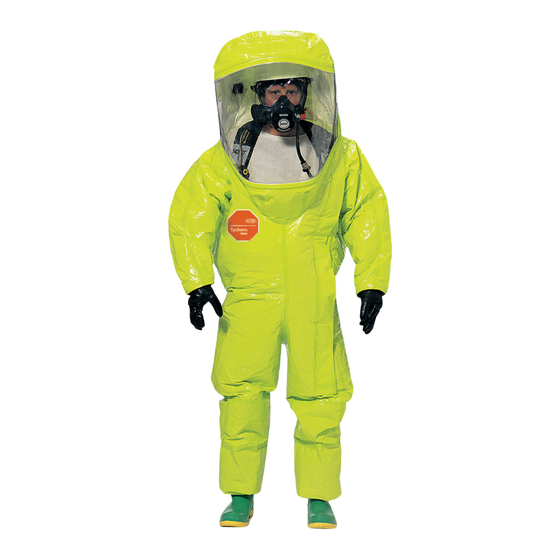- ページ 8
安全装置 Dupont Tychem VaporのPDF ユーザーマニュアルをオンラインで閲覧またはダウンロードできます。Dupont Tychem Vapor 20 ページ。 Garments

User Manual for DuPont
Storage Conditions
Store Tychem
garments in a cool, dark, dry location free of
®
dirt and insects. Sunlight, ozone, high temperatures (>120 °F),
exhaust fumes, compression under heavy weight and/or
sharp protrusions are some conditions known to degrade or
damage the materials in these suits.
Store Tychem
Level A and Level B encapsulating garments
®
in boxes, in bags, or on hangers. Never step on or place
heavy objects on top of chemical garments.
Sizing Considerations
Verify the fit of your Tychem
Use the sizing chart found at the end of this document to
select the appropriate size based on height and weight.
Obtain the size suit you intend to wear, don that size
garment, and perform a series of exercises to simulate your
movements under actual work conditions. A garment larger
or smaller than suggested in the chart may be preferred.
Sizing fit tests must include outer boots, head protection and
other PPE and accessories that the wearer will use during
actual use.
Donning Encapsulating Level A and B Garments
A donning training video for Tychem
available at safespec.dupont.com.
Have another person present when donning your chemical
protective ensemble. Use a stable chair, bench, or stool
which is free of sharp edges. If outdoors or where the
flooring is rough, use a ground cloth to avoid damaging your
garment.
1.
Conduct a visual inspection of the garment as described
above before beginning the donning steps
Ensure that the inner gloves (if applicable) are fully
inserted into the outer gloves (if applicable).
Check that the inside and outside of all exhaust valves
are free of obstructions such as caps, plugs, tape, or
foam padding.
2.
Remove all jewelry and personal items (pens, key rings,
badges, pagers, knife cases, etc.) that might damage the
garment.
8
Tychem
Encapsulated Level A and Encapsulated Level B Suits
™
®
garment before actual use.
®
encapsulating suits is
®
3.
Check function of your respirator system per the
manufacturer's instructions and place near donning
location.
4. Inspect outer boots per the manufacturer's instructions
and place them nearby.
5.
Open the garment closure completely.
6. Check the garment size label to verify the suit meets
your requirements.
7.
Apply an antifogging solution to inside surface of the
visor (if desired).
8. Remove your shoes. If the garment has attached socks,
these socks are to be worn inside outer chemical boots
(not provided with the Tychem
do not have adequate durability or slip resistance to be
worn as the outer footwear covering.
9. While sitting, insert your feet into the garment legs and
down into the attached socks, if so equipped. Stretch
your legs to maximum extension while pulling garment
up. Don outer chemical boots. If the garment is fitted
with boot flap covers, pull boot flap covers up and don
your outer boots. Then pull the boot flap covers down
over the outer boots as far as possible.
10. Stand and continue pulling the garment up to your
hips and connect and adjust the garment waist belt (if
equipped) until comfortably snug.
11. While standing, with garment at waist level, don your
respirator air tank.
12. Don your respirator face piece and check its function.
To conserve SCBA air supply, disconnect the air supply
from the face piece when the garment zipper closure
is open and you have access to fresh air. In the case of
an external airline breathing system, complete all other
connections and adjustments.
13. Don protective headgear and communication
equipment as appropriate.
suit). The attached socks
®
